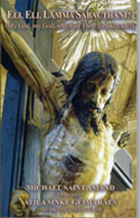Catholic Virtues
 |
 |
 |
 |
 |
 |
 |
St. Anne, Mother of the Glorious Virgin Mary - III
St. Anne in the Old & New World
It is fitting that France, the eldest daughter of the Church, has long honored St. Anne, the mother of the Virgin Mary. Two important shrines to St. Anne, both established by the French, have been responsible for spreading her devotion to millions.
St. Anne d’Auray
By the 6th century, the Catholic Faith was already flourishing in parts of modern-day France, and so was devotion to St. Anne. To express their love for the Saint, the faithful of Auray in Brittany built a chapel in her honor. Sadly, it was destroyed in the 7th century, but the people never forgot their patroness. The surrounding village came to be known as Keranna, meaning “Village of Anne.”
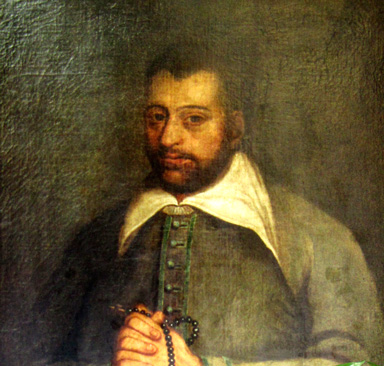 It was the time of the Protestant Revolution that God chose for the devotion to St. Anne to flourish in Auray, France. The mother of the Immaculate Virgin made herself known in these cold Calvinist days, bringing warmth and light into the hearts of Catholics, who from the start came in great crowds to honor her there.
It was the time of the Protestant Revolution that God chose for the devotion to St. Anne to flourish in Auray, France. The mother of the Immaculate Virgin made herself known in these cold Calvinist days, bringing warmth and light into the hearts of Catholics, who from the start came in great crowds to honor her there.
In the late 16th century, a child named Yves Nicolazic was born into a peasant home in Keranna, a small village in Britanny whose simple people had steadfastly kept the Catholic Faith. Nicolazic gained a reputation for his great piety and ardent devotion to St. Anne, whom he called his “beloved mother.”
At the time of the apparitions, Yves Nicolazic was 30 years old.One of his fields was called “le Bocenno.” Tradition held that this was the site of the ancient chapel dedicated to St. Anne. Indeed, this field seemed to be blessed: All the harvests abounded, and it was not necessary to let it lie fallow as with other fields.
St. Anne prepares Nicolazic for her coming
One evening in August of 1623, Nicolazic and his brother-in-law Le Roux were taking their oxen to drink at the village fountain. To their great astonishment, they encountered there a majestic and distinguished lady, radiant with light. She had a noble bearing and an angelic smile, but she remained silent. The two men said nothing to anyone about the beautiful lady.
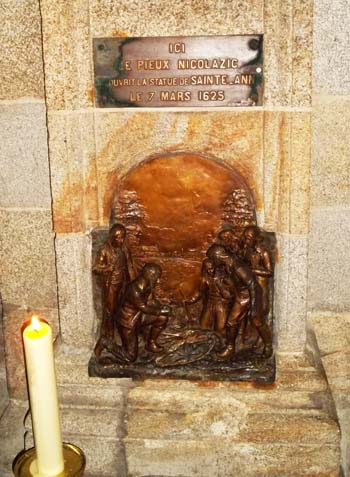 In the next months, Nicolazic continued to see the same lady frequently, either at the fountain, or at his home, or near the Cross on the road to Pluneret, since referred to as as “Nicolazic's Cross.” It was not long before others in the village learned of these extraordinary events. The parish priest, hoping to discover who this heavenly lady was, encouraged Nicolazic to speak with her.
In the next months, Nicolazic continued to see the same lady frequently, either at the fountain, or at his home, or near the Cross on the road to Pluneret, since referred to as as “Nicolazic's Cross.” It was not long before others in the village learned of these extraordinary events. The parish priest, hoping to discover who this heavenly lady was, encouraged Nicolazic to speak with her.
On July 25, 1624, the eve of St. Anne’s feast day, the beautiful lady again appeared to Nicolazic, and he asked her for her name. Speaking in his native Breton language she told him:
“Yves Nicolazic, fear not: I am Anne, mother of Mary. Tell your rector that once there was in the piece of land called the Bocenno, even before the village, a chapel, an earlier one dedicated to me in the country of the Bretons.
“Today it has been in ruins for 924 years and six months. I want it to be rebuilt as soon as possible, and I want you personally to see to this. It is God's wish that I be honored here."
The following year, on the night of March 7, St. Anne once again appeared and told Nicolazic that “the masses of people who will come to honor me in this place will be the greatest miracle of all.”
As proof of the divine origin of her message, she told him: “Take your brother-in-law and neighbors, and follow this torch to the place where it will lead you.” He did as she instructed, and the torch led them to his Bocenno field. There they unearthed at the foot of the torch a statue of St. Anne that had belonged to the ancient chapel.
Three days later, the pilgrims already began to arrive in droves to pray before the statue, fulfilling the prophecy of St. Anne. These multitudes have not stopped even up to these times.
After the Bishop gave permission for a new chapel to be built, Nicolazic himself helped to construct it. Soon, many people from all throughout France began to flock to the site. Many came seeking healing from ailments and left ex votos after being miraculously healed. There are hundreds of reported miracles from the 17th century alone.
St. Anne d’Auray was much beloved, but she was not without enemies. During the French Revolution, the ungodly revolutionaries, who hated all manifestations of piety, viewed St. Anne and this holy shrine as a threat. In an unthinkable act of malice, they plundered the little chapel and burned the miraculous statue of St. Anne.
Far from extinguishing devotion to St. Anne, the revolutionaries’ actions had the opposite effect, inspiring more and more people to make pilgrimages to the Chapel of Auray, covering its walls with ex-votos.
In the 19th century, the small chapel became insufficient to accommodate the large crowds. A large basilica was built in the mid-19th century, and on September 30, 1868, Pope Pius IX crowned a new statue of St. Anne there.
 To this day, the basilica of St. Anne d’Auray is one of the most popular pilgrimage sites in Europe. Around her feast day every year, around 20-30,000 pilgrims make a “Grand Pardon” pilgrimage. The Pardon is a typically Breton form of pilgrimage to a saint’s tomb or apparition site. The people travel by foot, confess and then assist at Mass presenting their petitions. In Auray there is a great candlelight procession every July 25, followed by an all night vigil.
To this day, the basilica of St. Anne d’Auray is one of the most popular pilgrimage sites in Europe. Around her feast day every year, around 20-30,000 pilgrims make a “Grand Pardon” pilgrimage. The Pardon is a typically Breton form of pilgrimage to a saint’s tomb or apparition site. The people travel by foot, confess and then assist at Mass presenting their petitions. In Auray there is a great candlelight procession every July 25, followed by an all night vigil.
Even in our days, when the Faith has been so dampened in the aftermath of Vatican II, the Revolution has not succeeded in dampening the love and admiration of the faithful of Brittany for Saint Anne.
St. Anne de Beaupré
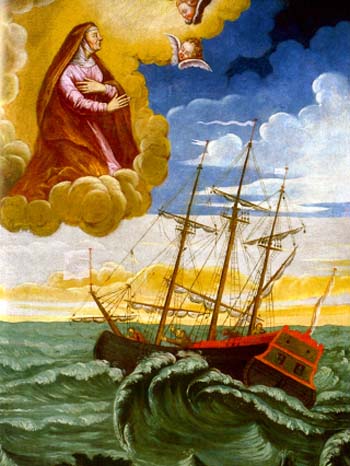 Not long after the Chapel of St. Anne d’Auray was built in France, French explorers in Canada spread the cult of St. Anne to the New World. In 1650, a group of sailors on the St. Lawrence River unexpectedly encountered a storm and feared they would be killed. They prayed to St. Anne, promising to dedicate a chapel to her if she helped them reach land safely. Their prayer was answered, and in the morning they arrived without any trouble in Beaupré, Quebec.
Not long after the Chapel of St. Anne d’Auray was built in France, French explorers in Canada spread the cult of St. Anne to the New World. In 1650, a group of sailors on the St. Lawrence River unexpectedly encountered a storm and feared they would be killed. They prayed to St. Anne, promising to dedicate a chapel to her if she helped them reach land safely. Their prayer was answered, and in the morning they arrived without any trouble in Beaupré, Quebec.
The promise was kept. In 1658, a man named Sir Etienne Lessard donated land for the chapel to be built, and construction soon began. A resident of Beaupré, Louis Guimond, who suffered from rheumatism, laid three stones for the chapel’s foundation and was instantly cured. The miracle had a profound impression on other locals, beginning a marvelous new era in Quebec’s history.
It did not take long for Beaupré to become a popular pilgrimage site, especially among Canadians. Just as in Auray, people visited the shrine of St. Anne de Beaupré with the hope of receiving physical healing or at least spiritual assistance. Even the Huron Indians made their first official pilgrimage in 1671, marching to the chapel behind priests, repeating the invocation, “Jésus, Marie, Joseph, Joachim et Anne, secóurez-nous.”
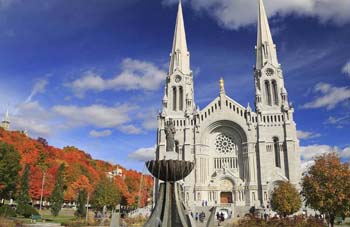 Multiple times, the small stone church had to be enlarged, and in the 19th century, it was replaced by a grand Basilica. In 1892, to reward the devotion of the faithful in Canada, Pope Leo XIII gave the new Basilica a precious relic: the arm bone of St. Anne.
Multiple times, the small stone church had to be enlarged, and in the 19th century, it was replaced by a grand Basilica. In 1892, to reward the devotion of the faithful in Canada, Pope Leo XIII gave the new Basilica a precious relic: the arm bone of St. Anne.
After this Basilica was tragically destroyed by a fire in 1922, the present-day structure was built. It remains among the most magnificent churches in the New World. Outside, visitors are greeted by a sweet and maternal statue of St. Anne holding her daughter, the Blessed Virgin Mary. Inside the 328-foot Basilica, built in Romanesque revival style with some gothic elements and in the shape of a cross, the pilgrim stands in wonder before paintings, mosaics, stained glass windows, and of course, the relics of St. Anne – a finger and parts of her arm – kept in a beautiful reliquary.
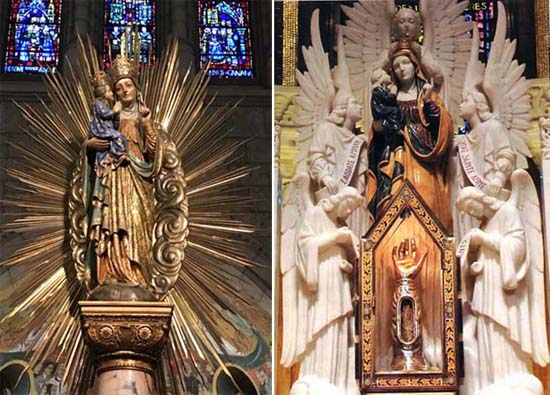 To this day, St. Anne shows her bountiful mercy to those who visit her shrine in Beaupré. Near the entrance of the church, one can find hundreds of crutches and canes left behind by pilgrims healed through the intercession of the great Saint.
To this day, St. Anne shows her bountiful mercy to those who visit her shrine in Beaupré. Near the entrance of the church, one can find hundreds of crutches and canes left behind by pilgrims healed through the intercession of the great Saint.
Conclusion
St. Anne desires to be known and loved by Catholics in both the New World and Old. In these dark days, devotion to this marvelous Saint is more important than ever. Let us call upon her, asking her to hasten the arrival of the Reign of Mary. For certainly in Heaven she awaits the day when the world will properly glorify her daughter, who will reign in, with and through her Divine Son Jesus.
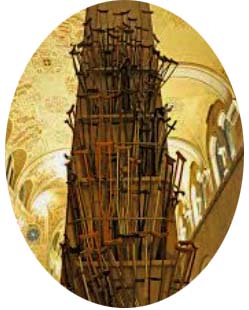

St. Anne d’Auray
By the 6th century, the Catholic Faith was already flourishing in parts of modern-day France, and so was devotion to St. Anne. To express their love for the Saint, the faithful of Auray in Brittany built a chapel in her honor. Sadly, it was destroyed in the 7th century, but the people never forgot their patroness. The surrounding village came to be known as Keranna, meaning “Village of Anne.”

Yves Nicolazic, the Breton peasant Our Lady chose to receive her message
In the late 16th century, a child named Yves Nicolazic was born into a peasant home in Keranna, a small village in Britanny whose simple people had steadfastly kept the Catholic Faith. Nicolazic gained a reputation for his great piety and ardent devotion to St. Anne, whom he called his “beloved mother.”
At the time of the apparitions, Yves Nicolazic was 30 years old.One of his fields was called “le Bocenno.” Tradition held that this was the site of the ancient chapel dedicated to St. Anne. Indeed, this field seemed to be blessed: All the harvests abounded, and it was not necessary to let it lie fallow as with other fields.
St. Anne prepares Nicolazic for her coming
One evening in August of 1623, Nicolazic and his brother-in-law Le Roux were taking their oxen to drink at the village fountain. To their great astonishment, they encountered there a majestic and distinguished lady, radiant with light. She had a noble bearing and an angelic smile, but she remained silent. The two men said nothing to anyone about the beautiful lady.

A bas-relief on a pillar points out the spot where Yves Nicolazic and his neighbors discovered the statue of St. Anne; below, a statue on the grounds of the Basilica today
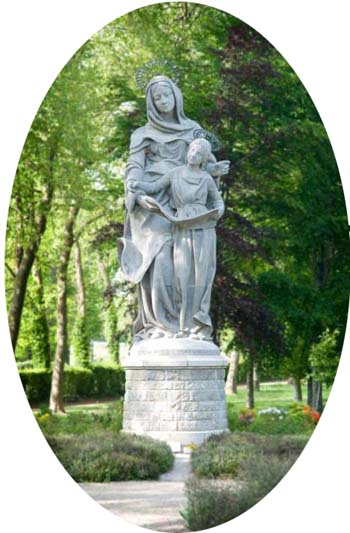
On July 25, 1624, the eve of St. Anne’s feast day, the beautiful lady again appeared to Nicolazic, and he asked her for her name. Speaking in his native Breton language she told him:
“Yves Nicolazic, fear not: I am Anne, mother of Mary. Tell your rector that once there was in the piece of land called the Bocenno, even before the village, a chapel, an earlier one dedicated to me in the country of the Bretons.
“Today it has been in ruins for 924 years and six months. I want it to be rebuilt as soon as possible, and I want you personally to see to this. It is God's wish that I be honored here."
The following year, on the night of March 7, St. Anne once again appeared and told Nicolazic that “the masses of people who will come to honor me in this place will be the greatest miracle of all.”
As proof of the divine origin of her message, she told him: “Take your brother-in-law and neighbors, and follow this torch to the place where it will lead you.” He did as she instructed, and the torch led them to his Bocenno field. There they unearthed at the foot of the torch a statue of St. Anne that had belonged to the ancient chapel.
Three days later, the pilgrims already began to arrive in droves to pray before the statue, fulfilling the prophecy of St. Anne. These multitudes have not stopped even up to these times.
After the Bishop gave permission for a new chapel to be built, Nicolazic himself helped to construct it. Soon, many people from all throughout France began to flock to the site. Many came seeking healing from ailments and left ex votos after being miraculously healed. There are hundreds of reported miracles from the 17th century alone.
St. Anne d’Auray was much beloved, but she was not without enemies. During the French Revolution, the ungodly revolutionaries, who hated all manifestations of piety, viewed St. Anne and this holy shrine as a threat. In an unthinkable act of malice, they plundered the little chapel and burned the miraculous statue of St. Anne.
Far from extinguishing devotion to St. Anne, the revolutionaries’ actions had the opposite effect, inspiring more and more people to make pilgrimages to the Chapel of Auray, covering its walls with ex-votos.
In the 19th century, the small chapel became insufficient to accommodate the large crowds. A large basilica was built in the mid-19th century, and on September 30, 1868, Pope Pius IX crowned a new statue of St. Anne there.

Sainte-Anne-d’Auray: the third most popular pilgrimage site in France,
after Lourdes & Lisieux
Even in our days, when the Faith has been so dampened in the aftermath of Vatican II, the Revolution has not succeeded in dampening the love and admiration of the faithful of Brittany for Saint Anne.
St. Anne de Beaupré

St. Anne saves a ship on sea & a promise is made to dedicate a chapel to her
The promise was kept. In 1658, a man named Sir Etienne Lessard donated land for the chapel to be built, and construction soon began. A resident of Beaupré, Louis Guimond, who suffered from rheumatism, laid three stones for the chapel’s foundation and was instantly cured. The miracle had a profound impression on other locals, beginning a marvelous new era in Quebec’s history.
It did not take long for Beaupré to become a popular pilgrimage site, especially among Canadians. Just as in Auray, people visited the shrine of St. Anne de Beaupré with the hope of receiving physical healing or at least spiritual assistance. Even the Huron Indians made their first official pilgrimage in 1671, marching to the chapel behind priests, repeating the invocation, “Jésus, Marie, Joseph, Joachim et Anne, secóurez-nous.”

The Sanctuary of Sainte-Anne-de-Beaupré, the oldest pilgrimage site in North America.
After this Basilica was tragically destroyed by a fire in 1922, the present-day structure was built. It remains among the most magnificent churches in the New World. Outside, visitors are greeted by a sweet and maternal statue of St. Anne holding her daughter, the Blessed Virgin Mary. Inside the 328-foot Basilica, built in Romanesque revival style with some gothic elements and in the shape of a cross, the pilgrim stands in wonder before paintings, mosaics, stained glass windows, and of course, the relics of St. Anne – a finger and parts of her arm – kept in a beautiful reliquary.

The famous statue of St. Anne de Beaupré & the precious relics housed there
Conclusion
St. Anne desires to be known and loved by Catholics in both the New World and Old. In these dark days, devotion to this marvelous Saint is more important than ever. Let us call upon her, asking her to hasten the arrival of the Reign of Mary. For certainly in Heaven she awaits the day when the world will properly glorify her daughter, who will reign in, with and through her Divine Son Jesus.

Crutches left behind by healed pilgrims at
St. Anne de Beaupré’s Shrine

Posted September 9, 2024














